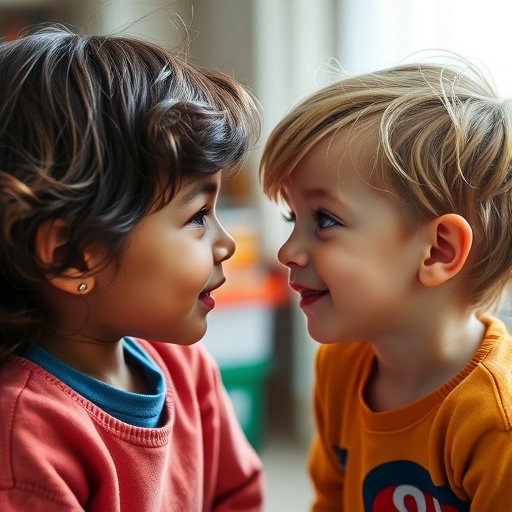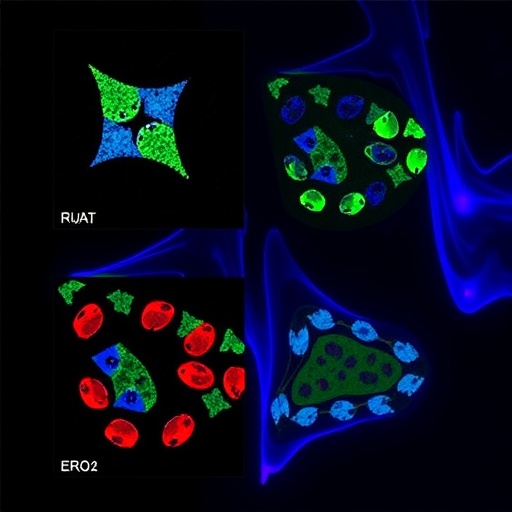Recent research conducted by Patel and Rollins sheds light on the potential of mutual gaze as a transformative tool in enhancing social attentiveness among children diagnosed with autism. This study, published in the upcoming 2025 edition of the Journal of Autism and Developmental Disorders, explores the intricacies of social interaction and highlights the often overlooked but critical component of eye contact in fostering connections between caregivers and autistic children.
Understanding autism spectrum disorder (ASD) necessitates delving into the unique challenges faced by individuals on the spectrum, particularly in their ability to engage socially. Children with autism may struggle with eye contact, which is vital for communication and emotional understanding. This lack of engagement can lead to further social isolation, perpetuating a cycle of disconnect between them and their peers. The work of Patel and Rollins seeks to address these issues through innovative therapies focused on mutual gaze.
The researchers implemented structured activities designed to encourage mutual gaze between caregivers and autistic children. These activities were deliberately constructed to be engaging and developmentally appropriate, incorporating play elements that promote natural interactions. The results of these activities showcased a significant increase in the duration and frequency of eye contact initiated by children during shared activities. This is particularly striking given the often rigid social responses observed in children with autism.
Further analysis revealed that when children engaged in mutual gaze, they not only responded better to social cues from their caregivers but also exhibited signs of increased emotional reciprocity. The ability to maintain eye contact seems to pave the way for deeper connections, enhancing the overall interaction quality. This is monumental because it bridges the gap that many autistic children experience in social settings, helping them develop essential skills for making friends and joining groups.
In a series of follow-up observations, Patel and Rollins noted that children who participated in mutual gaze exercises displayed greater interest in social activities outside of the structured sessions. Their willingness to engage with peers increased, and instances of social withdrawal appeared to decrease significantly. This finding underscores the transformative potential of mutual gaze as a continuing practice rather than a mere therapeutic intervention.
Notably, this study also underscores the importance of caregiver involvement in the therapeutic process. When caregivers actively engage and facilitate mutual gaze, they play a pivotal role in the developmental progress of their children. This research suggests that not only do children benefit from these interactions, but caregivers also report changes in their emotional connection with their children. The act of mutual gaze can foster greater empathy and understanding, enriching the parent-child bond.
Moreover, the implications of Patel and Rollins’ findings extend beyond the realm of autism. There is a growing recognition that enhancing mutual gaze capabilities can benefit all children, particularly those who may experience social difficulties. This study opens the door to broader applications, suggesting that mutual gaze strategies can be adapted for various developmental contexts. As educators and therapists begin to implement these findings, the landscape of childhood social development may evolve.
The results of this research also call for a reassessment of educational approaches towards autism. Traditional methods may not account for the importance of mutual gaze and the emotional engagement it fosters. By integrating gaze-centric activities into educational frameworks for children with autism, educators can create supportive environments that encourage peer interactions and enhance social skills.
Furthermore, Patel and Rollins emphasize the role of technology in their research. Innovative tools such as eye-tracking devices enable researchers to study gaze patterns in real-time, providing valuable insights into how children interact with their environment. This technology can help identify key moments where interventions can be most effective, allowing for a data-driven approach to enhancing social skills in autistic children.
As the research continues, it will be vital to advocate for policies that support the inclusion of mutual gaze strategies in therapeutic practices and educational settings. By spreading awareness of the significance of eye contact, practitioners can help dismantle the barriers that prevent autistic children from fully participating in social contexts.
The findings from Patel and Rollins not only advance our understanding of autism but also enrich our comprehension of human connection and communication at large. This research stands as a reminder of the power of simple human interactions, like eye contact, in fostering meaningful connections. It illustrates that even minor behavioral shifts can have profound ripple effects on the lives of children navigating the complexities of social engagement.
The journey of exploring mutual gaze and its effects on social attention in autistic children is just beginning. Future research will undoubtedly unravel further complexities and nuances inherent in mutual gaze interactions. The potential for larger-scale studies that encompass diverse cultural and social contexts promises to deepen our understanding of autism and communication.
As Patel and Rollins’ work garners attention within the scientific community, it inspires a renewed commitment to implementing findings in real-world contexts. With the potential to empower caregivers, educators, and, most importantly, the children themselves, the implications of this research reach far beyond academic debates. Optimizing mutual gaze techniques could transform how we approach social education and interaction for children with autism.
In summary, Patel and Rollins provide compelling evidence for the significance of mutual gaze as a key factor in facilitating social attention in autistic children. Their study not only highlights the need for innovative methods in therapy but also nudges society toward a more inclusive understanding of the challenges faced by individuals with autism. Through continued research and advocacy, the promise of fostering richer social interactions for these children is within reach.
Subject of Research: Mutual gaze’s impact on social attention in autistic children.
Article Title: Leveraging Mutual Gaze to Facilitate Social Attention in Autistic Children.
Article References:
Patel, S.D., Rollins, P.R. Leveraging Mutual Gaze to Facilitate Social Attention in Autistic Children.
J Autism Dev Disord (2025). https://doi.org/10.1007/s10803-025-07083-5
Image Credits: AI Generated
DOI: 10.1007/s10803-025-07083-5
Keywords: autism, mutual gaze, social attention, therapy, caregiver involvement, educational approaches, eye contact, emotional connection, technology, social skills.
Tags: autism spectrum disorder social challengescaregiver-child interactions in autismdevelopmental appropriateness in autism interventionsenhancing social skills in autistic childrenfostering connections in autismimpact of play on social skillsimportance of eye contact in communicationinnovative therapies for autismJournal of Autism and Developmental Disorders 2025mutual gaze in autism therapyresearch on autism and mutual gazestructured activities for social engagement





